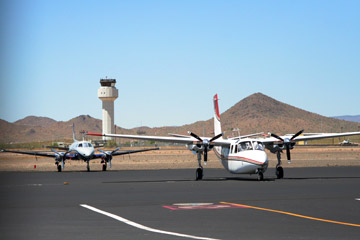Safety advocates worry that increasingly strapped airlines will try to further cut costs for repairs and maintenance.
“We believe that it’s like anything else. You get what you pay for,” said Linda Goodrich, a longtime FAA inspector who now serves as a vice president of Professional Aviation Safety Specialists, the union for FAA safety inspectors. “There’s nothing wrong with people trying to save money, but not at the expense of safety.”
Fatigue
The pilots flying Corporate Airlines Flight 5966 were on their sixth flight of the day as they approached Kirksville, Mo., the night of Oct. 19, 2004. Because it was dark and overcast, they were supposed to use their instruments to land the plane.
Instead the captain and first officer decided to find the runway by sight. They missed, crashing and killing themselves and 11 of 13 passengers.
The pilots had started their day at 4 a.m. and worked 14.5 hours. In its report, the NTSB noted that “fatigue likely contributed to (the pilots’) degraded performance.”
The safety board told the FAA it needed to come up with new scheduling rules for pilots to ensure they are rested. It was the same message the board had delivered at least 30 times before.
The issue of tired pilots dates back 75 years to when the director of the Department of Air Commerce requested a study on pilot fatigue.
In 1962, NTSB’s predecessor, the Civil Aeronautics Board, again questioned the amount of rest pilots were getting. The NTSB issued its first formal recommendation to limit pilot flying times 10 years later when it became an independent agency.
The FAA has tried several times to impose more limited shifts and more rest time between shifts – including new proposals issued in mid-September that would overhaul pilot work rules to reduce fatigue. Public comments are being accepted on those proposals, but industry groups are expected to object.
Opposition from airlines and pilot unions has derailed such proposals in the past. Airlines have said the measures would cost too much, and unions have expressed concern that while pilots’ days would be shorter, pilots would actually end up flying more hours in a day.
In the meantime, fatigue has contributed to more than 320 accidents and incidents since 1971 and killed more than 745 people, according to the News21-Center for Public Integrity analysis of FAA and NTSB data.
That includes a Colgan Airlines flight that crashed near Buffalo, N.Y., in 2009, killing 50. NTSB investigators said fatigue was a factor.
The accident produced an outcry from family members, safety advocates and politicians, and it led to a directive to reduce pilot fatigue that was included in the Airline Safety and Federal Aviation Administration Extension Act signed by President Obama in early August. The FAA released a proposal for public comment this month.
“It took an act of Congress,” said Jim Oberstar, D-Minn., chair of the House Committee on Transportation and Infrastructure. “Fatigue is one area that without a doubt has had the greatest resistance by airlines and which the FAA has been sporadic, to say the best.”
Future Concerns
While decades-old problems continue to bring down planes, experts worry that a projected growth in air travel could make things worse. Airplanes are more likely to encounter accidents on increasingly crowded runways. Cash-strapped airlines will be under pressure to reduce costs on repairs and maintenance. They may not be able to hire enough qualified pilots.
U.S. air traffic is expected to grow by more than 3 percent each year over the next decade, according to the FAA. And that means more planes competing for space on airport runways – and more chances for accidents to happen.


 Resistance in the Cockpit
Resistance in the Cockpit